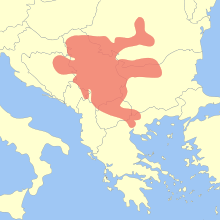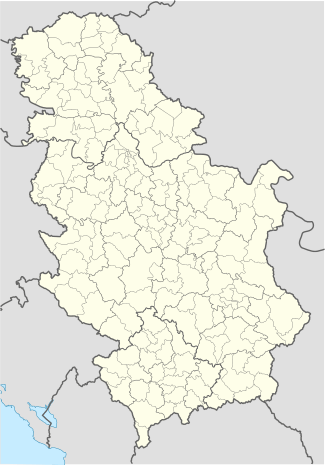Vinča culture
 | |
| Alternative names |
Turdaş culture Tordos culture Gradeshnitsa culture |
|---|---|
| Period | Middle Neolithic |
| Dates | c. 5700–4500 BC |
| Type site | Vinča-Belo Brdo |
| Major sites |
Belogradchik Drenovac Gomolava Gornja Tuzla Pločnik Rudna Glava Selevac Tărtăria Turdaş Vratsa Vršac |
| Characteristics |
Large tell settlements Anthropomorphic figurines Vinča symbols |
| Preceded by | Starčevo culture |
The Vinča culture, also known as Turdaș culture or Turdaș-Vinča culture, is a Neolithic archaeological culture in Central Europe and Southeastern Europe, dated to the period 5700–4500 BC.[1][2] Named for its type site, Vinča-Belo Brdo, a large tell settlement discovered by Serbian archaeologist Miloje Vasić in 1908, it represents the material remains of a prehistoric society mainly distinguished by its settlement pattern and ritual behaviour. Farming technology first introduced to the region during the First Temperate Neolithic was developed further by the Vinča culture, fuelling a population boom and producing some of the largest settlements in prehistoric Europe. These settlements maintained a high degree of cultural uniformity through the long-distance exchange of ritual items, but were probably not politically unified. Various styles of zoomorphic and anthropomorphic figurines are hallmarks of the culture, as are the Vinča symbols, which some conjecture to be the earliest form of proto-writing. Though not conventionally considered part of the Chalcolithic or "Copper Age", the Vinča culture provides the earliest known example of copper metallurgy.
Geography and demographics
The Vinča culture occupied a region of Southeastern Europe (i.e. the Balkans) corresponding mainly to modern-day Serbia, but also parts of Romania, Bulgaria, Bosnia, Montenegro, Macedonia, and Greece.[2]
This region had already been settled by farming societies of the First Temperate Neolithic, but during the Vinča period sustained population growth led to an unprecedented level of settlement size and density along with the population of areas that were bypassed by earlier settlers. Vinča settlements were considerably larger than any other contemporary European culture, in some instances surpassing the cities of the Aegean and early Near Eastern Bronze Age a millennium later. One of the largest sites was Vinča-Belo Brdo (a suburb of Belgrade, Serbia), it covered 29 hectare and had up to 2,500 people.[3]
Early Vinča settlement population density was 50-200 people per hectare, in later phases an average of 50-100 people per hectare was common.[1] The Divostin site 4900-4650 B.C. had up to 1028 houses and a maximum population size of 8200 and could perhaps be the largest Vinča settlement. Another large site was Stubline from 4700 B.C. it may have contained a maximum population of 4000. The settlement of Parţa maybe had 1575 people living there at the same time.[4][5][6][7][8][9]
Chronology
The origins of the Vinča culture are debated. Before the advent of radiocarbon dating it was thought, on the basis of typological similarities, that Vinča and other Neolithic cultures belonging to the 'Dark Burnished Ware' complex were the product of migrations from Anatolia to the Balkans. This had to be reassessed in light of radiocarbon dates which showed that the Dark Burnished Ware complex appeared at least a millennium before Troy I, the putative starting point of the westward migration. An alternative hypothesis where the Vinča culture developed locally from the preceding Starčevo culture—first proposed by Colin Renfrew in 1969—is now accepted by many scholars, but the evidence is not conclusive.[10][11]
The Vinča culture can be divided into two phases, closely linked with those of its type site Vinča-Belo Brdo:[12]
| Vinča culture | Vinča-Belo Brdo | Years BCE |
|---|---|---|
| Early Vinča period | Vinča A | 5700–4800 |
| Vinča B | ||
| Vinča C | ||
| Late Vinča period | Vinča D | 4800–4200 |
| Abandoned |
Decline
In its later phase the centre of the Vinča network shifted from Vinča-Belo Brdo to Vršac, and the long-distance exchange of obsidian and Spondylus artefacts from modern-day Hungary and the Aegean respectively became more important than that of Vinča figurines. Eventually the network lost its cohesion altogether and fell into decline. It is likely that, after two millennia of intensive farming, economic stresses caused by decreasing soil fertility were partly responsible for this decline.[13]
According to Marija Gimbutas, the Vinča culture was part of Old Europe – a relatively homogeneous, peaceful and matrifocal culture that occupied Europe during the Neolithic. According to this hypothesis its period of decline was followed by an invasion of warlike, horse-riding Proto-Indo-European tribes from the Pontic-Caspian steppe.[14]
Economy
Subsistence
Most people in Vinča settlements would have been occupied with the provision of food. They practised a mixed subsistence economy where agriculture, animal husbandry and hunting and foraging all contributed to the diet of the growing Vinča population. Compared to earlier cultures of the First Temperate Neolithic (FTN) these practices were intensified, with increasing specialisation on high-yield cereal crops and the secondary products of domesticated animals, consistent with the increased population density.[15]
Vinča agriculture introduced common wheat, oat and flax to temperate Europe, and made greater use of barley than the cultures of the FTN. These innovations increased crop yields and allowed the manufacture of clothes made from plant textiles as well as animal products (i.e. leather and wool). There is indirect evidence that Vinča farmers made use of the cattle-driven plough, which would have had a major effect on the amount of human labour required for agriculture as well as opening up new area of land for farming. Many of the largest Vinča sites occupy regions dominated by soil types that would have required ploughing.[15]
Areas with less arable potential were exploited through transhumant pastoralism, where groups from the lowland villages moved their livestock to nearby upland areas on a seasonal basis. Cattle were more important than sheep and goats in Vinča herds and, in comparison to the cultures of the FTN, livestock was increasingly kept for milk, leather and as draft animals, rather than solely for meat. Seasonal movement to upland areas was also motivated by the exploitation of stone and mineral resources. Where these were especially rich permanent upland settlements were established, which would have relied more heavily on pastoralism for subsistence.[15]
Though increasingly focused on domesticated plants and animals, the Vinča subsistence economy still made use of wild food resources. The hunting of deer, boar and aurochs, fishing of carp and catfish, shell-collecting, fowling and foraging of wild cereals, forest fruits and nuts made up a significant part of the diet at some Vinča sites. These, however, were in the minority; settlements were invariably located with agricultural rather than wild food potential in mind, and wild resources were usually underexploited unless the area was low in arable productivity.[15]
Industry


Generally speaking craft production within the Vinča network was carried out at the household level; there is little evidence for individual economic specialisation. Nevertheless, some Vinča artefacts were made with considerable levels of technical skill. A two-stage method was used to produce pottery with a polished, multi-coloured finish, known as 'Black-topped' and 'Rainbow Ware'. Sometimes powdered cinnabar and limonite were applied to the fired clay for decoration. The style of Vinča clothing can be inferred from figurines depicted with open-necked tunics and decorated skirts. Cloth was woven from both flax and wool (with flax becoming more important in the later Vinča period), and buttons made from shell or stone were also used.[16]
The Vinča site of Pločnik has produced the earliest example of copper tools in the world. However, the people of the Vinča network practised only an early and limited form of metallurgy.[17] Copper ores were mined on a large scale at sites like Rudna Glava, but only a fraction were smelted and cast into metal artefacts – and these were ornaments and trinkets rather than functional tools, which continued to be made from chipped stone, bone and antler. It is likely that the primary use of mined ores was in their powdered form, in the production of pottery or as bodily decoration.[16]
Major Vinča sites
- Belogradchik
- Drenovac
- Gomolava
- Gornja Tuzla
- Pločnik
- Rudna Glava
- Selevac
- Tărtăria
- Turdaş
- Vinča-Belo Brdo, the type site
- Vratsa
- Vršac
See also
Notes
- 1 2 Suciu 2011.
- 1 2 Chapman 2000, p. 239.
- ↑ Chapman 1981, pp. 40–51.
- ↑ Archaeological Exhibitions. Duncan Caldwell.
- ↑ EVALUATIONS OF THE DOMESTICATION PROCESS IN SERBIA - PALEZOOLOGICAL REMNANTS AT NEOLITHIC SETTLEMENT OF BELOVODE (PDF). JOVANOVI S, SAVIC MILA, TRAILOVI RU@ICA, JANKOVIC Z. SLJIVAR D,. 2003.
- ↑ The rise of metallurgy in Eurasia: Evolution, organisation and consumption of early metal in the Balkans. University College London, Institute of Archaeology. 2010.
- ↑ Social complexity and inequality in the Late Neolithic of the Central Balkans> reviewing the evidence (PDF). Marko Por;ic´ Department of Archaeology, Faculty of Philosophy, University of Belgrade, RS. 2012. p. 171.
- ↑ An exercise in archaeological demography estimating the population size of Late Neolithic settlements in the Central Balkans (PDF). Marko Por;ic´ Department of Archaeology, Faculty of Philosophy, University of Belgrade, RS.
- ↑ Newsletter of the Association for Coroplastic Studies Number 12, Summer 2014 (PDF). Association for Coroplastic Studies. 2014.
- ↑ Chapman 1981, pp. 1–5.
- ↑ Chapman 1981, pp. 33–39.
- ↑ Chapman 1981, pp. 17–32; calibrated with CalPal.
- ↑ Chapman 1981, pp. 132–139.
- ↑ Gimbutas 1976.
- 1 2 3 4 Chapman 1981, pp. 84–116.
- 1 2 Chapman 1981, pp. 117–131.
- ↑ Cvekic 2007.
References
- Chapman, John (1981). The Vinča culture of south-east Europe: Studies in chronology, economy and society (2 vols). BAR International Series. 117. Oxford: BAR. ISBN 0-86054-139-8.
- Chapman, John (2000). Fragmentation in Archaeology: People, Places, and Broken Objects. London: Routledge. ISBN 978-0-415-15803-9.
- Cvekic, Ljilja (12 November 2007). "Prehistoric women had passion for fashion". Reuters. Retrieved 23 September 2010.
- Gimbutas, Marija A., ed. (1976). Neolithic Macedonia as reflected by excavation at Anza, southeast Yugoslavia. Los Angeles: Institute of Archaeology, University of California.
- Suciu, Cosmin Ioan (2011). "Early Vinča Culture Dynamic in South-Eastern Transylvania". In Mills, Steve; Mirea, Pavel. The Lower Danube in Prehistory: Landscape Changes and Human-Environment Interactions. Bucharest: Editura Renaissance. pp. 75–86. ISBN 978-606-8321-01-1.
Further reading
- Vasić, Miloje (1932). Preistorijska Vinča I [Prehistoric Vinča I]. Beograd.
- Vasić, Miloje (1936). Preistorijska Vinča II [Prehistoric Vinča II]. Beograd.
- Vasić, Miloje (1936). Preistorijska Vinča III [Prehistoric Vinča III]. Beograd.
- Vasić, Miloje (1936). Preistorijska Vinča IV [Prehistoric Vinča IV]. Beograd.
- Ian Shaw, Robert Jameson: A Dictionary of Archaeology. Wiley, 2002, ISBN 0631235833, p. 606 (online copy, p. 606, at Google Books)
External links
| Wikimedia Commons has media related to Vinča culture. |
